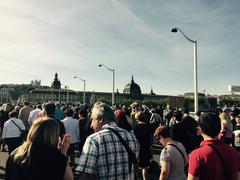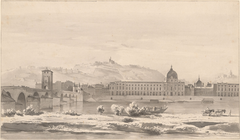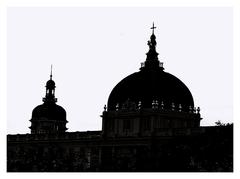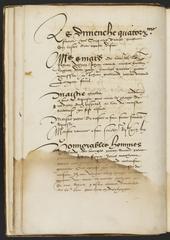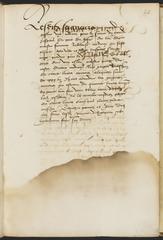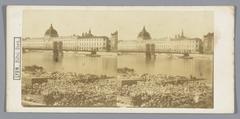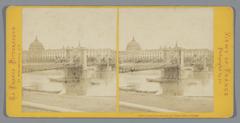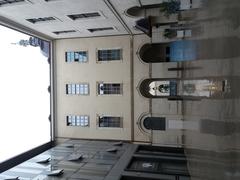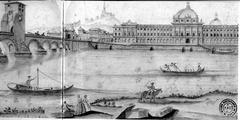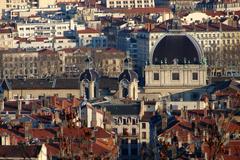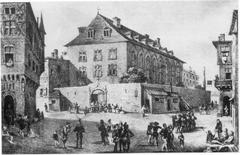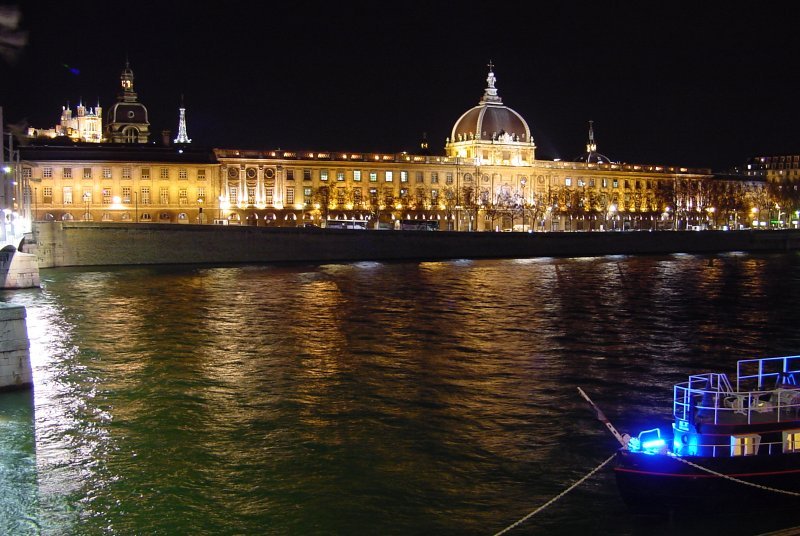
Hôtel-Dieu de Lyon: Visiting Hours, Tickets, and Historical Significance
Date: 14/06/2025
Introduction
The Hôtel-Dieu de Lyon is one of France’s most treasured and iconic historical sites. Located on the Presqu’île—between the Rhône and Saône rivers in the heart of Lyon—this monumental building has witnessed the city’s evolution over more than eight centuries. Originally founded in the 12th century as a charitable hospital, the Hôtel-Dieu has been at the crossroads of Lyon’s social, medical, and architectural history. Today, it stands revitalized as a vibrant cultural, gastronomic, and hospitality complex, blending its medieval, Renaissance, and neoclassical heritage with modern leisure and luxury.
This comprehensive guide provides all essential information for visitors: a detailed historical overview, architectural highlights, practical visitor details—including opening hours, ticketing, accessibility—and answers to frequently asked questions. Whether you are a history enthusiast, an architecture lover, a foodie, or a traveler exploring Lyon, the Hôtel-Dieu offers a unique window into the city’s past and present (Forbes, France.fr, Visiter Lyon).
Table of Contents
- Introduction
- Historical Overview
- Architectural Highlights
- Cultural and Gastronomic Significance
- Essential Visitor Information
- FAQs
- Travel Tips & Nearby Attractions
- Conclusion
- References
Historical Overview
Medieval Foundations
Founded in the 12th century, the Hôtel-Dieu de Lyon’s earliest records date to 1184. The term “Hôtel-Dieu” refers to medieval hospitals dedicated to caring for the poor, sick, and travelers. Managed by religious orders and under the auspices of the Cathedral of Saint John, its mission was both medical and spiritual—providing refuge, sustenance, and healing. Its strategic location on the Presqu’île made it accessible to locals and travelers arriving by river (Forbes).
Renaissance and Enlightenment Expansion
As Lyon prospered in the 16th and 17th centuries, the hospital expanded to serve the city’s growing population. The Renaissance brought new wings and ornate facades. The most significant transformation came in the 18th century, when Jacques-Germain Soufflot—famed architect of the Panthéon in Paris—redesigned the hospital. His neoclassical Grand Dôme, completed in 1755, remains the building’s architectural centerpiece, symbolizing Lyon’s urban ambition and civic pride. The riverfront façade, stretching over 375 meters, reflects Enlightenment ideals of symmetry and grandeur (France.fr).
Transformation and Restoration
The Hôtel-Dieu functioned as Lyon’s principal hospital for over 800 years, training generations of physicians and serving as a bulwark during epidemics and wars. By the early 21st century, its medical facilities were outdated. After closing in 2010, the site underwent Europe’s largest private restoration project, led by architects Albert Constantin and Didier Repellin. This four-year endeavor preserved original features—stonework, beamed ceilings, domes—while introducing modern elements for new uses, including a luxury hotel, boutiques, restaurants, and cultural spaces (Aimer Savoir).
Architectural Highlights
The Hôtel-Dieu’s architecture is a palimpsest of styles. Its medieval cloisters echo its origins, while Renaissance and Baroque wings introduce decorative elegance. The Soufflot Dome, with its harmonious proportions and soaring height, dominates the central courtyard and is visible across Lyon. The Chapelle Notre-Dame de la Pitié, a Baroque masterpiece, features gilded altars and luminous frescoes. Five main courtyards, arcaded galleries, and monumental facades invite exploration and contemplation (Lyon Visite, en.visiterlyon.com).
Cultural and Gastronomic Significance
The Hôtel-Dieu was always more than a hospital; it was a pillar of Lyon’s social welfare and scientific progress. Renowned physicians, such as François Rabelais, worked here, and the institution’s records chronicle the city’s evolution. Today, the revitalized site celebrates Lyon’s culinary heritage. The Cité Internationale de la Gastronomie (temporarily closed as of 2025) explored the links between health, food, and French art de vivre, while acclaimed restaurants and gourmet shops uphold Lyon’s reputation as a world capital of gastronomy (France.fr).
Essential Visitor Information
Location & Access
- Address: 1 Place de l’Hôpital, 69002 Lyon, France
- District: Presqu’île, a short walk from Place Bellecour
Getting There:
- Metro: Lines A & D (Bellecour station)
- Bus: Lines 27, S1, C20, 40 (Bellecour Le Viste or nearby stops)
- Car: Nearby parking at Gailleton, Indigo, or Antonin Poncet lots (Grand Hôtel-Dieu Practical Info)
Opening Hours
- Shops: Monday–Saturday, 10:00 AM – 7:30 PM
- Restaurants/Bars: Open daily to 1:00 AM
- Courtyards/Gardens: Daily, 7:30 AM – 1:00 AM (Cour du Midi & Cour du Cloître close at 8:00 PM)
- Special Attractions: Museums and exhibitions have individual schedules; check websites for details (Grand Hôtel-Dieu Opening Hours)
Tickets & Tours
- General Access: Free for public spaces, courtyards, and gardens
- Guided Tours: €10 (adults), €6 (reduced); children under 8 free. Book onsite or online. The Lyon City Card may offer free access to select tours (en.visiterlyon.com)
- Special Exhibitions: Ticketed entry for attractions like the Museum of Illusion or seasonal events (Grand Hôtel-Dieu Tickets)
Facilities & Accessibility
- Restrooms: Available throughout the complex
- Accessibility: Fully equipped for visitors with reduced mobility (elevators, ramps)
- Wi-Fi: Complimentary in public areas and the InterContinental Lyon – Hôtel Dieu
- Information Desk: Near main entrance, with maps and multilingual assistance
- Parking: On-site (reservation recommended, fees apply)
- Dining: From casual cafés to gourmet restaurants (notably Epona and Le Dôme Bar)
- Accommodation: The InterContinental Lyon – Hôtel Dieu offers 143 luxury rooms and suites (Visitons Lyon – The God Hotel)
Frequently Asked Questions (FAQ)
Q: What are the Hôtel-Dieu Lyon visiting hours?
A: Shops: Mon–Sat, 10:00 AM–7:30 PM; restaurants/bars: daily until 1:00 AM; courtyards/gardens: 7:30 AM–1:00 AM (some close earlier).
Q: Is there an admission fee?
A: Public areas are free; guided tours and some attractions require tickets.
Q: Is the site accessible for visitors with disabilities?
A: Yes, the Hôtel-Dieu is fully accessible.
Q: Are pets allowed?
A: The InterContinental hotel is pet-friendly; public areas allow pets on a leash except in certain indoor spaces.
Q: Is parking available?
A: Yes, on-site parking is available (reservation recommended, fees apply).
Q: How do I get there using public transport?
A: Take Metro lines A or D to Bellecour station; buses and trams serve the area.
Q: Are guided tours available?
A: Yes, themed tours are available—check schedules online.
Travel Tips & Nearby Attractions
- Visit early on weekdays for a quieter experience.
- Combine your visit with a stroll through Lyon’s UNESCO World Heritage center, including Place Bellecour, Vieux Lyon, and Fourvière Basilica.
- Use public transport to avoid parking fees.
- Dress comfortably; some fine-dining venues may request smart-casual attire.
- Lyon is welcoming to international visitors—French and English are spoken in most shops and venues.
Conclusion
The Hôtel-Dieu de Lyon is far more than an architectural marvel; it is a living testament to Lyon’s resilience, creativity, and hospitality. From its medieval roots as a refuge and hospital, through centuries of architectural transformation, to its rebirth as a center for culture, shopping, and gastronomy, the Hôtel-Dieu is a must-visit for anyone seeking to experience Lyon’s layered history and vibrant present. Plan your visit using this guide and enjoy all the heritage, beauty, and flavors that this exceptional site has to offer.
For the latest updates, tickets, and special events, visit the official Grand Hôtel-Dieu website and the Lyon tourism portal.
References
- Forbes
- France.fr
- Visiter Lyon
- Aimer Savoir
- Lyon Visite
- en.visiterlyon.com
- Grand Hôtel-Dieu
- Visitons Lyon – The God Hotel

